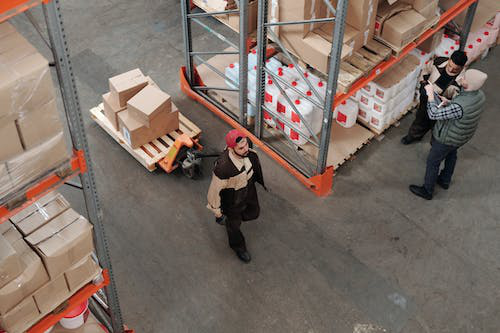In professional and personal settings, lifting heavy objects is a common task. Whether it’s in a warehouse, on a construction site, or simply moving furniture at home, improper lifting techniques can lead to serious musculoskeletal injuries. Understanding and implementing safe lifting techniques is paramount to prevent such injuries and promote overall health and safety.
In this comprehensive guide, we’ll discuss the principles of safe lifting, equip you with practical lifting techniques, and empower you to safeguard yourself against potential harm.
Here’s what you need to know:
Understanding the Risks
Before delving into the specifics of safe lifting techniques, it’s crucial to comprehend the risks associated with improper lifting. Musculoskeletal injuries, such as strains, sprains, and even more severe conditions like herniated discs, can result from lifting heavy objects incorrectly. These injuries cause immediate pain and discomfort, leading to long-term issues and impacting mobility and quality of life.
Moreover, they can result in lost workdays, decreased productivity, and increased healthcare costs. By adopting proper lifting techniques, individuals can mitigate these risks significantly.
Key Principles of Safe Lifting Techniques:
Safe lifting techniques include several key principles to help reduce muscle strains and minimize injury risks. Understanding and adhering to these principles form the foundation of safe lifting practices:
1. Maintain Proper Posture
Proper posture forms the foundation of safe lifting. It involves aligning the body in a manner that minimizes muscle strain and maximizes stability. Here’s how to maintain proper posture while lifting:
- Stand with your feet shoulder-width apart to create a stable base of support.
- Keep your back straight and avoid rounding or arching it excessively.
- Pull your shoulders back and down to engage the upper back muscles.
- Tighten your abdominal muscles to support the spine and stabilize the core.
1. Bend at the Knees
Bending at the knees, rather than the waist, is crucial for protecting the lower back during lifting. When you bend at the knees, you engage the muscles of the legs, which are stronger and better equipped to handle the load. Here’s how to bend at the knees properly:
- Begin by standing close to the object you intend to lift.
- Bend your knees while keeping your back straight, lowering your body toward the object.
- Aim to squat down until your thighs are parallel to the ground or as close as possible without causing discomfort.
- Keep the weight of your body centered over your feet to maintain balance and stability.
2. Keep the Load Close
Keeping the load close to your body while lifting is essential for minimizing the strain on your muscles and reducing the risk of injury. When you hold the load away from the body, you create additional leverage and place more stress on your muscles, particularly the lower back. Here’s how to keep the load close:
- Position yourself as close to the object as possible before lifting.
- Grasp the object firmly with both hands, maintaining a secure grip.
- Keep the object centered in front of your body, avoiding any excessive reaching or stretching.
- Draw the load in toward your body by hugging it close to your chest or abdomen as you lift.
3. Lift with Your Legs
Lifting with your legs, rather than relying solely on your back muscles, is essential for distributing the weight evenly and reducing the strain on your spine. The muscles of the legs, including the quadriceps, hamstrings, and glutes, are larger and more powerful than the muscles of the back, making them better suited for lifting heavy objects. Here’s how to lift with your legs:
- Push through your heels as you straighten your legs, using the strength of your leg muscles to lift the load.
- Keep your back straight and avoid leaning forward as you lift.
- Maintain a controlled and steady pace, avoiding sudden or jerky movements that could strain your muscles.
4. Avoid Twisting
Twisting the body while lifting or carrying heavy objects can place excessive stress on the spine and increase the risk of injury, particularly to the muscles and discs of the lower back. Instead of twisting, it’s important to pivot the entire body to change direction, keeping the load centered and balanced. Here’s how to avoid twisting:
- Before lifting, assess the pathway and ensure no obstacles or hazards that could require twisting to navigate.
- Pivot your feet and turn your entire body in the direction you need to go, keeping the load centered in front of you.
- Avoid twisting at the waist or hips, as this can strain the muscles and joints of the spine.
- Take small, controlled steps to maintain balance and stability while carrying the load.
Practical Techniques for Safe Lifting
Now that we’ve outlined the key principles of safe lifting techniques, let’s explore practical strategies to implement them effectively in various lifting scenarios:
1. Assess the Load
Before attempting to lift any object, it’s essential to assess its weight, size, and shape. Understanding the characteristics of the load allows you to determine whether it can be safely lifted and carried using manual methods or if additional assistance or mechanical aids are required. Here’s how to assess the load effectively:
- Estimate the weight of the object by lifting one corner or side slightly to gauge its heaviness.
- Consider the size and shape of the object, as irregularly shaped or bulky items may require special handling techniques.
- Determine if you can safely lift the object by yourself or if you require assistance from colleagues or mechanical aids, such as dollies, carts, or forklifts, if necessary.
- Consider any environmental factors, such as uneven terrain or restricted pathways, that may impact the lifting and carrying process.
1. Plan Your Approach
Planning your approach to lifting involves considering various factors, such as the pathway, obstacles, and destination, to ensure a safe and efficient lifting operation. By taking the time to plan, you can identify potential hazards and implement strategies to mitigate risks. Here’s how to plan your lifting approach:
- Survey the lifting area and identify any potential hazards, such as obstacles, slippery surfaces, or overhead obstructions.
- Clear the lifting area of debris, clutter, or other hazards that could impede your movement or cause accidents.
- Determine the best pathway for transporting the load to its destination, considering factors such as distance, terrain, and accessibility.
- Communicate with colleagues or team members to coordinate lifting activities and ensure everyone knows their roles and responsibilities.
- Establish a plan for communicating and signaling during the lifting process, especially in noisy or busy environments where verbal communication may be limited.
2. Seek Assistance
Lifting heavy or awkward objects alone can significantly increase the risk of injury. When faced with a load that exceeds your capabilities, you must seek assistance from colleagues or use mechanical aids to handle the object safely. Here’s how to seek assistance effectively:
- Assess the weight and size of the object to determine if it requires additional help or equipment to lift.
- Communicate with colleagues or team members to request assistance, ensuring everyone knows their roles and responsibilities.
- Use mechanical aids, such as dollies, carts, or forklifts, to assist with lifting and transporting heavy objects safely.
- If working alone, consider breaking down the load into smaller, more manageable parts or using leverage techniques to reduce the amount of force required for lifting.
3. Break It Down
Breaking down large or bulky loads into smaller, more manageable parts is an effective strategy for reducing the risk of injury and making lifting easier and safer. By dividing the load into smaller components, you can distribute the weight more evenly and reduce the strain on your muscles. Here’s how to break down loads effectively:
- Identify any large or bulky items you can disassemble or break down into smaller parts.
- Use tools or equipment, such as wrenches, screwdrivers, or saws, to dismantle the load safely and efficiently.
- Divide the load into smaller components that can be lifted and carried individually or with less effort.
- Ensure you properly secure each component and stabilize them before attempting to lift or transport it.
4. Pace Yourself
Rushing when lifting heavy objects can lead to careless mistakes and increase the risk of injury. It’s important to pace yourself, take your time, and focus on maintaining proper form and technique throughout the lifting process. Here’s how to pace yourself effectively:
- Take a moment to assess the lifting task and plan your approach before starting.
- Avoid rushing or hurrying through the lifting process, as this can lead to poor posture and increased strain on your muscles.
- Focus on breathing deeply and evenly to oxygenate your muscles and maintain energy levels.
- Take short breaks as needed to rest and rehydrate, especially when performing prolonged or repetitive lifting tasks.
- Listen to your body and immediately stop if you experience pain, discomfort, or fatigue, as these are signs of potential injury.
5. Listen to Your Body
Paying attention to your body’s signals is essential for preventing injury and ensuring safe lifting practices. It’s important to listen to your body and respond to any signs of discomfort, strain, or fatigue promptly. Here’s how to listen to your body effectively:
- Be aware of how your body feels before, during, and after lifting heavy objects.
- Monitor for any signs of pain, discomfort, or fatigue, especially in the muscles of the back, shoulders, and legs.
- Stop immediately if you experience pain or discomfort while lifting, and assess your technique and approach.
- Take breaks as needed to rest and allow your muscles to recover, especially during prolonged or repetitive lifting tasks.
- If you experience persistent or severe pain, seek medical attention promptly to prevent further injury or complications.
By incorporating these practical lifting techniques for safe lifting into your daily routine, you can significantly reduce the risk of musculoskeletal injuries and promote overall health and safety in the workplace and beyond.
Empower your workforce with essential safety skills! Metro Safety offers comprehensive training services, including occupational first aid levels 1, 2, and 3, fall protection, and confined space safety. Enhance your team’s safety knowledge with our expert-led courses in Surrey. Enrol now to access level 2 first aid training in Surrey and fall protection training.
Ensure compliance and mitigate risks in the workplace. Don’t miss out on our specialized courses like occupational first aid level 2in Surrey and confined space training. Stay ahead in safety with Metro Safety’s accredited programs.
Book your spot today for unparalleled safety training!










